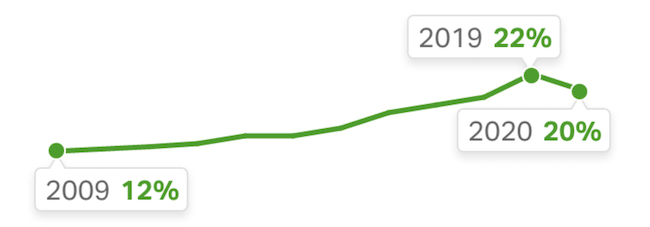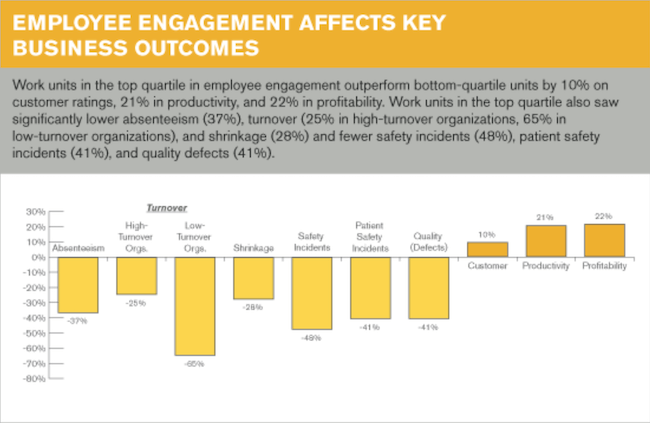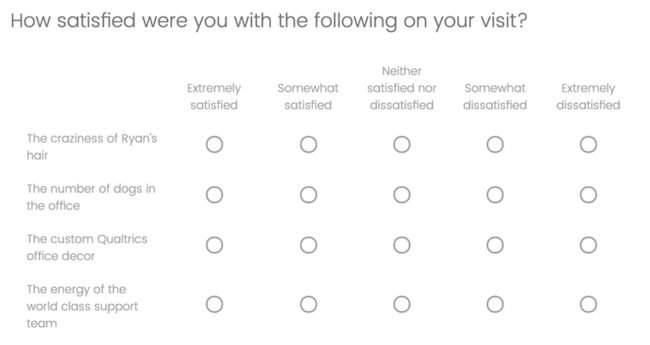 Companies with a highly engaged workforce are: 21% more productive, 22% more profitable and score 10% higher customer ratings, with fewer negative business outcomes such as absenteeism, accidents, and quality defects:
Companies with a highly engaged workforce are: 21% more productive, 22% more profitable and score 10% higher customer ratings, with fewer negative business outcomes such as absenteeism, accidents, and quality defects: 
17 min read
Want to find out how to boost engagement while reducing attrition? Then go straight to the source: your people. Here’s some tips for creating an employee engagement survey, the questions you need to ask, and a checklist to get started right away.
Your company’s financials have never looked better, but there’s word of multiple employees submitting their notice. What’s going on? The last all-employee survey (from, er, 2020) didn’t hint at any issues or point to employees planning to leave. And yet, morale has dipped. If only there was a way to ask employees how they’re feeling about their work… Enter the employee engagement survey – a comprehensive tool for assessing point-in-time employee sentiment, collecting data, and implementing actionable insights. Of course, it doesn’t take a dip in morale or a change in leadership to want a pulse on your organisation. More and more organisations check in with their employees at regular intervals to ask questions about what they’re thinking – upping the once-annual frequency to bi-annual, quarterly, or even monthly employee engagement surveys. Haven’t designed an employee engagement survey before? Here’s what you need to know to create one for your company. Want to gauge your employee engagement now? Download our free template.
Put simply, engagement is how someone thinks, feels, and acts to help their organisation achieve its goals. An employee engagement survey, then, measures the engagement of your people so that you can analyse the data and take action to improve employee engagement levels. Hub Article: Become an expert with our Ultimate Guide to Employee Engagement
According to Gallup’s State of the Global Workplace just 20% of the global workforce felt engaged in 2020. That’s down from 22% in 2019 (blame the COVID-19 pandemic) but a considerable improvement on 12% in 2009. But improvement or not, these stats mean that a whopping 80% of the world’s employees are not engaged at work. And because employee disengagement impacts business performance, retention, and workplace culture, it’s essential that organisations address the issue if they are to remain productive and competitive.  Companies with a highly engaged workforce are: 21% more productive, 22% more profitable and score 10% higher customer ratings, with fewer negative business outcomes such as absenteeism, accidents, and quality defects:
Companies with a highly engaged workforce are: 21% more productive, 22% more profitable and score 10% higher customer ratings, with fewer negative business outcomes such as absenteeism, accidents, and quality defects: 
Designing an effective employee engagement survey requires careful thought to return the best possible results and data. To start, keep your survey structure simple and intuitive. Employees will need to understand how to answer the questions and your managers will need to understand how to read the report. Your goal is for as many employees as possible to understand and act on the results of your engagement survey.
Here’s what else you’ll need to think about before you get started:
Your employee engagement survey should not only help you solve a problem at your organisation, but also point to what you’re doing right in the eyes of engaged employees. To accomplish this, you need to be sure that your questions are going to deliver useful insights into their employee experience.
If you’re starting to worry about formulating the right employee engagement survey questions, don’t. Designing your own employee engagement survey means that you don’t have to ask a question in a certain way to fit into a particular model – every question can be designed to be 100% relevant to your organisation, which can help make your survey shorter and easier to digest.
Your questions should cover three key areas:
These questions go at the front of your survey, and measure: intent to stay, work involvement, discretionary effort, pride in the company, and willingness to recommend the organisation.
These ask about the conditions that might cause (or detract from) employee engagement with questions about autonomy and empowerment, career progression, collaboration, communication, leadership, recognition, resources, strategy, management support, and training and development.
Depending on what’s happening in your company or market at the time, you might also want to ask about additional topics. In our employee engagement survey template you’ll find some additional ones you can include. Try to avoid throwing them all in, and only ask them if they’re relevant to prevent your engagement survey from becoming too unwieldy.
Your next step is to identify the themes you want to measure, and then create employee engagement survey questions that support those themes. As a rule of thumb, aim to ask 30-50 employee experience-related questions. Remember to include a way to record demographics, too.
| Autonomy / Empowerment | Are people empowered in their roles and able to innovate on the job? |
| Career Progression | Are there opportunities for people to grow and develop in the company? |
| Collaboration | Are they able to easily work with other teams or colleagues without barriers or conflict? |
| Communication | Are they getting enough info from the company about what’s happening and do they feel they’re being listened to? |
| Company Leadership | Do employees believe in and trust their senior leaders? |
| Recognition | Do people feel that they’re recognised and appreciated? |
| Resources | Are they enabled to do their job through the equipment they’re given? |
| Strategy Alignment | Do they buy into where the company is going and how they’re a part of it? |
| Supportive Management | Are managers supporting their teams to be successful? |
| Training and Development | Do they feel they have the training they need to do their job? |
| Customer Focus | Are they in a customer centric organisation and are they empowered to do what’s needed? |
| Diversity & Inclusion | Do they feel the organisation is inclusive and fair to all employees? |
| Pay & Benefits | Do people feel they’re fairly rewarded for what they put in? |
| Quality of Product or Services | Do people believe in what they (and/or the organisation) provide to their customers? |
| Safety | Do people feel their safety is critical to the organisation? |
| Social Responsibility | Do they feel the company is a good corporate citizen with a worthwhile cause? |
| Work-life Balance | Do they feel the company allows them to achieve the balance they need between work and personal life? |
Tip: In line with the industry standard, we recommend that employee engagement surveys use a 5-point Likert scale for all items:

These effective sample employee engagement survey questions will help you to distinguish the current employee satisfaction level. You’ll notice the questions cover several of the key engagement themes mentioned above.
Q1 How satisfied or dissatisfied are you with your ability to do interesting work in your role?
Q2 How satisfied or dissatisfied are you with your ability to apply your skills in this role?
Q3 How satisfied or dissatisfied are you with your current workload?
Q4 How satisfied or dissatisfied are you with your opportunities for career progression?
Q5 How satisfied or dissatisfied are you with the physical environment at your workplace?
Q6 How satisfied or dissatisfied are you with your relationship with your manager?
Q7 Overall, how satisfied or dissatisfied are you with your current employer?
The point of employee engagement survey questions is to achieve accurate responses and a high employee feedback response rate. By including questions that are obscure, too difficult to answer, too demanding, or too personal, you risk your survey being abandoned or discredited. Some terrible questions about employee experience we have seen include:
Q1 Does traveling for work affect your relationship with your partner (if you have one)? Far too personal and intrusive!
Q2 Does your manager appear to favour some employees over others? Who? Employees will be too afraid to answer this and unwilling to snitch on colleagues
Q3 What has been your experience of working with the company over the last year? Where to begin with this? Do you want an essay? Far too long and demanding.
Q4 On a scale of 1 to 10 how fairly do you think your manager treats the team? (1 being extremely unfairly, 10 being very fairly) Fairness is a subjective concept, particularly when you are being asked to answer for other people as well here, and impossible to pin on a scale of 1 to 10. There’s no definite answer, therefore a pointless question.
Q5 What KPIs do you think we achieved B2B in the YTD? Just what does this mean? (Translation: what key performance indicators do you think we achieved business to business in the year to date?) Avoid jargon and acronyms in your surveys, although even without the acronyms this is a pretty poor question.
Every organisation will have its own needs when it comes to assessing employee engagement. To expedite the process, we’ve created a survey template and outlined the steps to take to get your employee engagement survey up and running.
| Task | Tip |
|---|---|
| Get started | Try our free employee engagement survey template. |
| Determine who will review and approve content | While several people and teams should review content, avoid having more than one leader approve content. This will help you eliminate lengthy sign-off processes once you have a final question set. |
| Set clear deadlines and turnaround times | For everyone involved. |
| Involve key leaders when prioritising issues | Solicit opinions and ideas from stakeholders to better understand organisational needs. What do the heads of your business really need from their people in order to be successful? |
| Review and customise the engagement categories | Remove any you don’t think are relevant to your organisation, and add any new ones you would like to include. |
| Review the questions | Within each of the categories you have left. |
| Distinguish ‘nice to have’ questions from ‘must have’ questions | And adjust the questions to fit your needs. Maintain at least three questions in each category. |
| Include necessary definitions on your survey | For example, many companies include a definition of “Your Manager”, “Your Team”, “Senior Leadership” and “This organisation” to ensure people use the same frame of reference when responding. These can be shown at the beginning of a survey or, depending on your survey vendor, as individuals hover over questions. |
| Send your questionnaire for review and approval | Typically you should expect around two to three rounds of iteration which can take at least two weeks. |